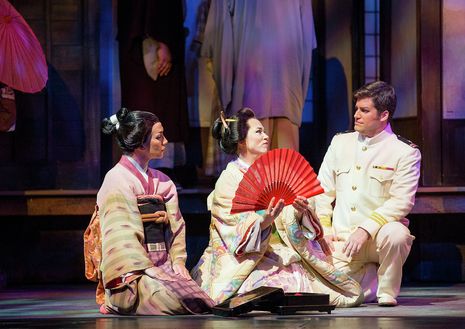Forget rap, opera is misogynistic too
It’s time we rethink the moral double standards we apply to the western canon

I was watching a football compilation video on YouTube when my attention strayed to the rap song probably chosen at random as backing music; I started growing uncomfortable as I became aware of how misogynistic the lyrics sounded. As my listening preferences are predominantly classical, I was rather unprepared for the sexism that’s apparently par for the course in a lot of rap lyrics. But before I could clutch my pearls and bemoan the degeneracy of contemporary culture, I stopped short at the thought of how much misogyny ran amok in the opera I listened to growing up.
The Mozart-Da Ponte operas were my gateway to the genre, but boy are they problematic. The best-known aria in Don Giovanni catalogues the serial womaniser’s numerous conquests, while its second-most famous aria describes his plan to pick up girls from the street and ply them with drink in order to “augment his list”. Così Fan Tutte is infamous for its protagonists deceiving their girlfriends with the intention of proving the claim that “All women are fickle”. Sure, the chauvinists get their comeuppance in the end, and I might have drawn some vaguely feminist moral from these shenanigans. But, turning our attention back to the stories actually being presented, one cannot help but wonder what all these relics of 18th century misogyny are doing in modern theatres.
“Moral failings amass like dust in every crevice of the western cultural pantheon”
Opera’s history of racism is just as bad as its sexism – and it hasn’t gone away. Even a boycott from an esteemed black soprano didn’t stop a prestigious venue using blackface in a 2022 production of Aida; operas like Madama Butterfly and Turandot are rife with Orientalist caricatures of Asia at the apex of western art.
Theatres and venues may proclaim their commitment to diversity and equality, yet how much change can we really create when show calendars continue to depend on staging the same depictions of cultural appropriation, racism or sexual coercion?
Beyond opera, moral failings amass like dust in every crevice of the western cultural pantheon. Schoolroom and stage remain suffocated by a canon shockingly dissonant with “modern” values. Shakespeare’s Caliban prefigures centuries of imperialist stereotyping of native peoples as primitive savages. The Taming of the Shrew is hard enough to read even before remembering it was written for a stage from which women were banned.
Of course, it’s not as simple as placing all the blame on dead writers for reflecting the moral shortcomings of their age. None of us wants to admit our generation’s greatest works will probably be shunned by 25th century critics. In the meantime, postcolonial rewrites of classics or genderswapped castings are a tempting cop-out. But such strategies only attempt to find a way to live with the elephant in the room, instead of trying to get rid of it altogether. In essence, they absolve all faults through rebaptism under a different creed.
“It is crucial that we stop putting morals from bygone eras on a pedestal”
And the more we dance around the root of the issue, the more we find ourselves trapped by the same old hierarchies. Doing A-level Literature on the Singapore syllabus, the only nod to non-English culture in the texts we studied was the stipulation that one of the unseen poems be Singaporean. Somehow the horny half-rhymes of the 17th century English metaphysical poets were assumed to be worthier of attention than the works of any other time and place in literary history.
In a world where the humanities are already under attack from the STEM-worshipping vultures of Sunak and co, surely we wouldn’t like to give them the argument that the humanities aren’t just useless, but actively harmful as well, putting problematic morals from bygone ages on a gilded pedestal.
Yet maybe the values we are so keen to shun in disgust still dominate our stages precisely because they are endemic to the modern world which pretends to have outgrown them. The sexism and racism native to the canon aren’t sequestered in yellowed manuscripts: they lurk among us still, barely concealed by the patina of political hypercorrectness. We struggle against the canon the same way we struggle against present injustice, against the darker demons of our nature, the subconscious biases wired centuries-deep into our culture.
When looking out from our cocoon of western liberalism at parts of the world where women are disempowered or racism abounds, and when keeping in mind the stories we have passed down through the ages, we can reach the necessary realisation that we aren’t all that different from them – give or take a couple generations.
And despite this, these selfsame stories, the deeply flawed classics we grow up with, constitute some of the greatest achievements of western art. They embody the best and worst of humanity all at once, a stark reminder that the one often comes with the other. Pope sums it up in his Essay on Man: we are “Created half to rise, and half to fall”.
 News / SU reluctantly registers controversial women’s soc18 December 2025
News / SU reluctantly registers controversial women’s soc18 December 2025 Features / Should I stay or should I go? Cambridge students and alumni reflect on how their memories stay with them15 December 2025
Features / Should I stay or should I go? Cambridge students and alumni reflect on how their memories stay with them15 December 2025 News / Dons warn PM about Vet School closure16 December 2025
News / Dons warn PM about Vet School closure16 December 2025 News / Cambridge study finds students learn better with notes than AI13 December 2025
News / Cambridge study finds students learn better with notes than AI13 December 2025 Comment / The magic of an eight-week term15 December 2025
Comment / The magic of an eight-week term15 December 2025









